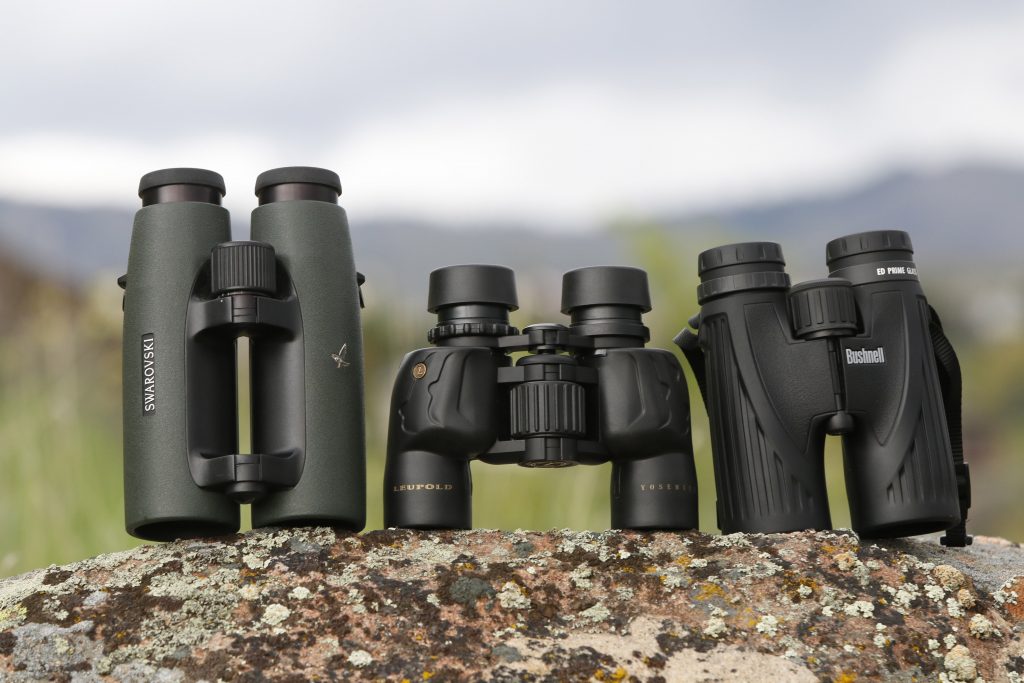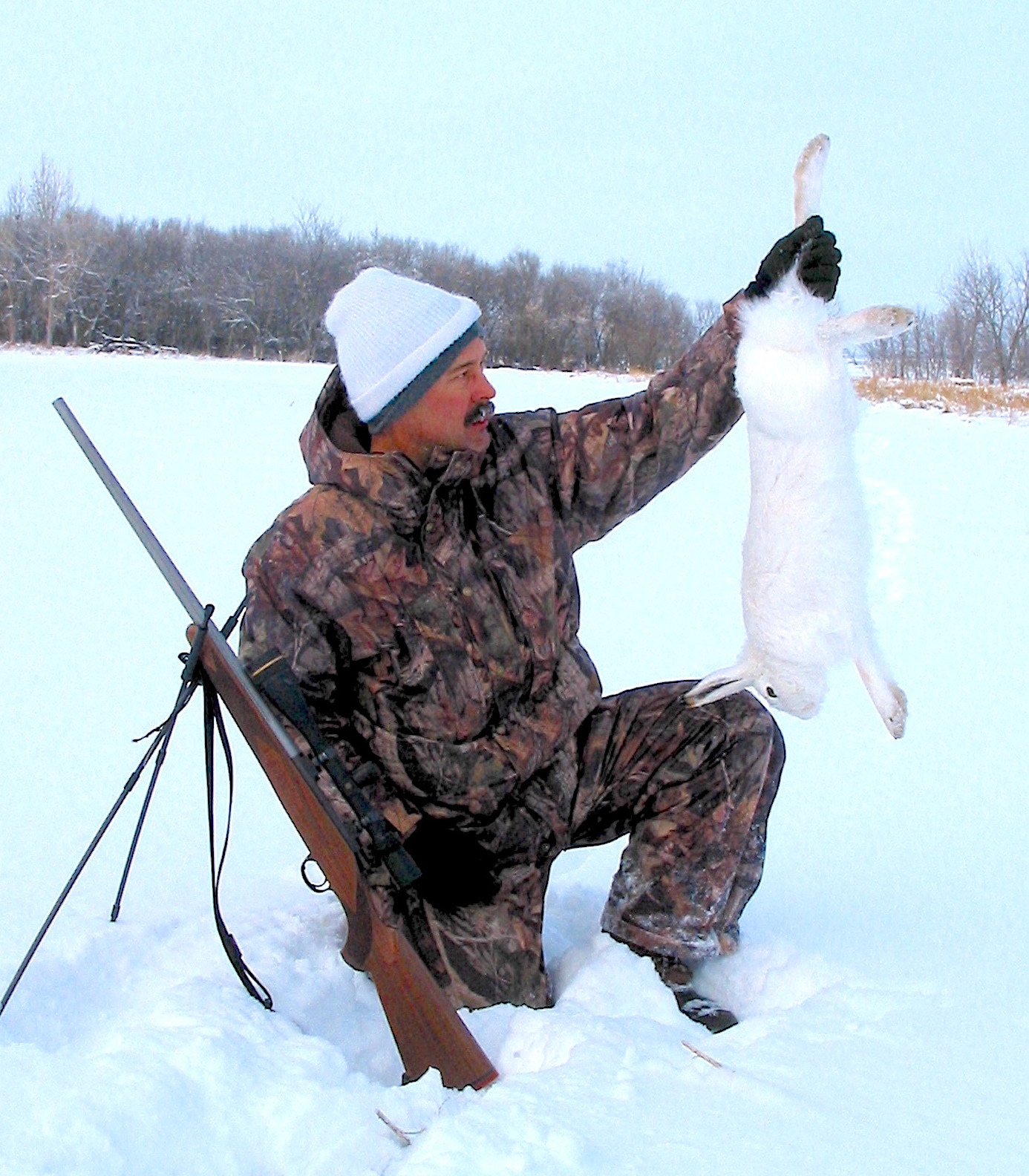Every hunter should use a binocular. Most would benefit from a spotting scope, too. Here’s why…
Binoculars and spotting scopes make you Superhunter. They won’t let you see through walls with X-ray vision, but they’ll help you spot game. A lot of game. More game than you’ll ever see with naked vision alone. And, not just in the wide open. Binoculars in heavy forest cover can reveal deer and elk you only thought you could see without them.
But first you have to get the right tools. The wrong optics are almost as bad as none at all.
In a nutshell, here is what to look for in high quality optics:
- Multi-coated lenses. Multiple layers of anti-reflection coatings maximize brightness and minimize flare and glare. Big objective, small objective, low power, high power. Doesn’t matter. Anti-reflection coatings are your biggest brightness bang for your buck. And they don’t weigh anything.
- Perfectly formed and ground lenses. Of course, this is even more basic than coatings, but with computer-controlled machining and polishing these days, that’s pretty much a given unless you get suckered into plastic lenses.
- High quality prisms. This is the glass inside you’ll never see. In Porro prism binoculars the glass type doesn’t matter much, doesn’t require mirrors, and is a best-buy for the dollar. But in more compact roof prisms you usually need a mirror. Aluminum is blah, silver is darn good, but dielectric is best. In addition, roof prisms must be phase coated for optimum sharpness. BAK-4 prism glass is usually considered optimum in roof prisms.
- Good balance between objective lens diameter and power. The two work in concert to provide the exit pupil (EP), the circle of light that exits the eyepiece and enters your pupil. If the EP is smaller than your pupil, you don’t get maximum brightness. If larger, the extra light is wasted, but you have more room in which to wander before seeing edge blackout. 8x42X and 10x50X with 5.25mm and 5mm EPs are your best compromise.
- Balance, strength, durability, and waterproof. All these little things add up to make or break a bino or spotter. Hard to describe but you know it when you feel it.
- Guarantee. High quality optics these days come with some pretty impressive warranties. Look for good ones.
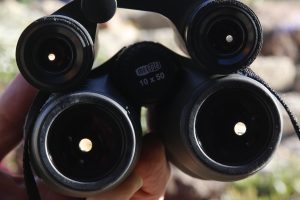
Now, here are the binoculars to consider for different hunting styles/habitats/terrain:
Woods and tight cover. 6X with 30- to 42mm objectives. You rarely see 6X binos, but in heavy cover they are ideal. Get much more power and you lose field of view. A 10X in the trees can be disorienting. What looked like a cluster of trees with perhaps an antler tine in the mix becomes one big trunk at 10X. Where’d that antler go? At 6X you have a much wider view. Things make sense, but enlargement is more than enough to see that the tine is connected to a head nibbling leaves. With 30mm objectives 6X yields a big, 5mm exit pupil. Plenty bright.
Mixed habitat and terrain from woods to meadows to prairies. The all-round 8×42 is perfect. You can go up to 10X, but the 10s are more limiting in brush and woods. At 8X you have a useable field of view, yet sufficient power to pick up game two miles away.
Big mountains, open plains. 10X to 12X with objective large enough to keep a 4mm or larger exit pupil. This means 42mm minimum at 10X, 50mm at 12X. (Divide objective diameter by power to get EP diameter.) A 4mm EP is about as small as you want.
15X and higher. These are specialty tools for use on a tripod or beanbag rest to minimize shake. Use them like a spotting scope to pick apart the landscape and spot bedded game. Pain in the butt to carry.
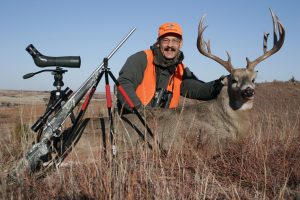
Spotting Scope
A big spotter is most valuable for studying detail on antlers, heads, hides, etc. But it works well for locating game as far as five miles under ideal conditions. Think of a spotting scope as one half of a binocular. Same ingredients apply. Biggest difference is the power and zooming ability.
Spotting scopes come with zoom eyepieces that dial from 15X to 45X, 20-60X, sometimes 25-70X. Image quality generally goes down as power goes up due to wind vibration and atmospheric conditions, like haze, smoke, and humidity. Often 45X is the top end useable power, but on clear, cold days 60X can be spectacular. At 60X we’ve determined legal rams at five miles out, counted tines pretty accurately on caribou and elk at three miles. I routinely use a spotter from a high point to scout meadows and fields miles away, locate game, then move in.
The other invaluable use of a spotter is to really fine tune trophy judging. If you’re looking for that last inch or horn, a spotter will work when a binocular fails.
Optical quality in a spotter comes from the same ingredients in a binocular. The biggest challenge is getting an objective lens large enough to keep the EP high. An 80mm objective at 20X is a nice 4mm EP, but dial the power to just 40X and it’s down to 2mm. At 60X that 80mm yields just a 1.3mm EP. Jumping up to a huge 90mm objective increases 60X EP to just 1.5mm! Things get dim, at high power. Multi-anti-reflection coatings are critical in a spotter.
Another useful lens is an ED (extra-low dispersion) or HD lens, meaning fluorite. This kind of glass minimizes color fringing, a halo or rim of color that appears around the edges of objects at 20X and above. The higher the power, the more of this color fringing you’ll see. An ED lens virtually eliminates it.
In addition, you might want a rotating collar. This is useful with an angled eyepiece. It lets you stay behind the spotter, spin the barrel, and angle the eyepiece so your partner can see what you’re looking at without having to reorient the scope.
A pop- or twist-out lens hood is useful for keeping rain off the objective lens and shading it from direct sun rays.
Techniques for Spotting Scope Use
A solidly anchored tripod or bean bag atop a car window or hood is mandatory. You can sometimes handhold at 20X and find things, but there’s too much wiggle for effective study. Use a bean bag or window-mount tripod from a vehicle, and a sitting or standing height tripod when hiking. Get the tripod as low as possible to thwart winds. Remove straps, dangling lens covers — anything that vibrates in the wind. Most serious glassers sit behind their spotting scope. An angled eyepiece is the ultimate in comfort for this. Just look down into it.
Your Optics Team
I think of binocular and scope as my optical dream team. I use the binocular to scan the landscape section by section for obvious game, then switch to the spotter to size things up. If I can’t find game with the bino, I’ll scour bedding cover or reach miles with the spotter.

My biggest challenge has always been carrying all the glass I’d like. Backpack mountain hunting is especially challenging. Every ounce counts. If I’m after easily spotted game like Dall’s, mountain goats, black bears, and pronghorns (standing), I’ll often compromise with a little, light 8×32 or even 8×20 binocular. EP is small, but if optical quality is good, these are enough to find game. At that point I always need a closer look, which my spotting scope provides. So, I save weight in the binocular and invest it in the spotting scope. The tripod doubles for holding the camera and even as a walking staff. The extra weight of the spotter pays for itself by eliminating a lot of climbing and hiking to get closer for a look-see.
Save Money
It’s often said, “Spend the most you can afford for optics,” but that’s not 100% true these days. Computer design and manufacturing have made it possible for any serious optics maker to learn or steal the best designs and create high-quality products as long as they tighten up quality control. In addition, they reduce labor costs by hiring cheap labor in Pacific Rim countries. Finally, there are so many optics brands and so much competition that costs have plummeted. It’s getting to the point where casual hunters can’t detect any difference between $250 and $1,000 instruments. That doesn’t mean there aren’t any, but if you can’t see it… Still, consider brand reputations, guarantees, and potential durability issues. Durability is something you learn later, but you can at least turn and adjust dials for smoothness when new. Anything rough, sloppy or with a hitch suggests poor workmanship.
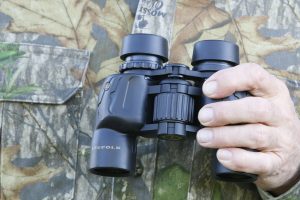
When comparing, do so under poor light conditions, ideally looking toward the low sun at something in the shadows. The better you can see things sharply and brightly in those shadows, the better that binocular is performing.
Finally, your best buy is always a Porro prism binocular. This is the old-fashioned looking type with a step in each barrel. These are easier to make with fewer expensive ingredients, but they are often built cheap with poor weatherproofing, so check that out before buying. Find a Porro model with internal focus, guaranteed waterproofing, and smooth, tight operation and you could match the optical quality of a $1,000 roof prism for $150.
